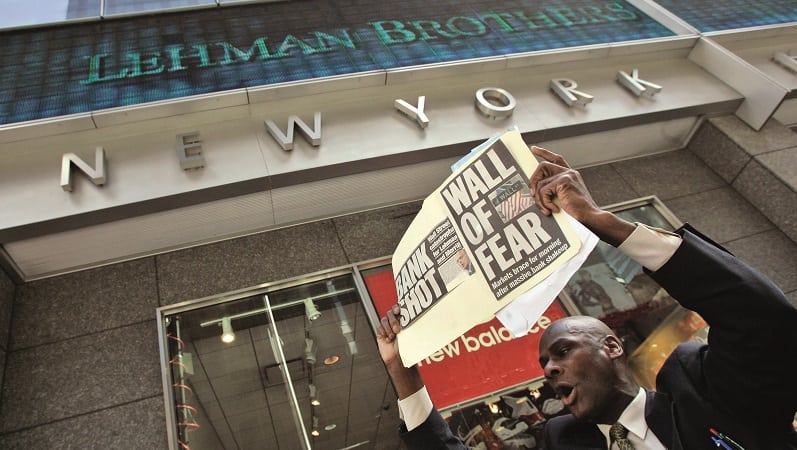Investors are at risk of getting caught out in a market correction as fixed income allocations languish at lows not seen since before the Lehman crisis.
Surging inflation and energy prices have given way to a fast and furious selloff in bond markets.
“This year’s rise in bond yields is of historic proportions,” JP Morgan reflected in a recent analyst note. “The 90bp year-to-date rise in the Global Aggregate bond index yield taking place in a period of less than three months, represents the steepest rise since 1994. At the time the Global Aggregate bond index yield had risen by 230bp during the course of a year.”
This has had a dramatic impact on asset allocations. Bonds made up just 18% of non-bank investors’ portfolios globally at the end of the first quarter, according to estimates from JP Morgan, the lowest proportion since 2008.
“Effectively 14 years of previous bond overweights have been already erased and investors’ positioning has transitioned to the pre-Lehman crisis norms,” it said in the note.
As investors have been abandoning bonds in droves, they have been piling into equities. The long equity/short fixed income divide is similarly approaching pre-Lehman crisis levels.
Retail investors driving long equity/short bond allocations
Retail investors have been a “significant force” behind this rotation, JP Morgan added. Redemptions from fixed income funds increased sevenfold in February to £2.4bn from £344m in January, according to stats from the Investment Association.
Peter Sleep, senior investment manager at 7IM, says the data shows portfolio managers are expecting to lose money on bonds so have resorted to “taking the volatility brakes off” and are consequently overweight risk.
However, such an asymmetrical overweight to equities versus bonds leaves investors in a precarious place. With several Wall Street analysts forecasting a US recession toward the end of 2023, this means investors could be caught wrong-footed.
Fixed income still has a place in multi-asset portfolios
Professional fund buyers who spoke to Portfolio Adviser have still been maintaining a decent level of exposure to fixed income, despite rising inflationary pressures, for this reason.
AJ Bell’s Balanced fund currently has around 29% allocated to bonds. Head of active portfolios Ryan Hughes says this reflects the firm’s diversified approach and long-term asset allocation, which views investments over a five-to-10-year time horizon.
Until recently, a decade of QE and ultra-low interest rates have implied “equities are the only game in town”, Hughes admits, “but you still need a little bit of insurance in the portfolio”.
“You just don’t know when something’s going to happen in the world that suddenly means that yields have to tighten. Things change and it’s generally in those environments where your bond exposure, government or corporate, will probably help you out and dampen losses in the portfolio.
“I would be loath to rule the entire bond market out and place all of my chips on equities and hope that that’s right for the long run.”
Tilney Smith & Williamson multi-asset head Ben Seager-Scott agrees: “Clearly not holding conventional government bonds has been beneficial over the last couple of years but with these moves accelerating in recent weeks, it’s important to think about the conditions that one would choose to start dipping the toe back in, especially for the traditional diversification benefits that government bonds can offer when yields are reasonable.”
Opportunities in short-dated govvies and credit
Tilney S&W took profits on its US TIPS positions, held for most of last year, in the first quarter. However at current yield levels, Seager-Scott says the team is starting to see areas of interest, particularly at the shorter-dated ended.
“We’ve liked short-dated corporate credit for a while, but now we’re looking at three-to-five-year gilts whilst keeping a watching brief on the five-to-10 year range,” he says.
The AJ Bell Balanced fund has around 3% in short-dated gilts and 5% in short-dated UK corporate investment grade bonds. Exposure to UK investment grades in total is just shy of 10%.
“The long-term return of standard dated gilts still looks pretty poor and therefore short-dated looks more appealing to protect capital obviously if those values fall. For UK investment grade, the element of yield pick-up from high-quality corporates is definitely more appealing than the government bond market in the long-term.”
Flight to quality
If a recession hits, Sleep says investors are in trouble either way due to equities and bonds being more positively correlated.
However, in the event of a crisis, he thinks there will still be a flight to quality. “Things like US Treasuries or Japanese government bonds will rise in sterling terms, although holding those assets now is an unpleasant experience.”
Analysts at JP Morgan also believe the current bond sell-off will be short-lived.
“The historical experience suggests that severe bond fund outflows do not last more than one quarter outside crisis periods such as the Lehman crisis. Because of this historical experience and because of the low bond weighting, we believe that this quarter’s rotation will subside into the coming quarters implying less bond fund selling and less equity fund buying in Q2 and beyond.”







